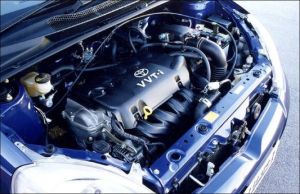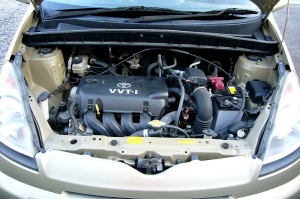
Engine 2NZ-FE
 The power units of the NZ series are represented by two low-volume engines with four cylinders, an aluminum block and 16 valves. A series of units has been produced since 1999. The motors have a common design, a short piston stroke. Designed to save fuel and were installed on the younger models of the concern.
The power units of the NZ series are represented by two low-volume engines with four cylinders, an aluminum block and 16 valves. A series of units has been produced since 1999. The motors have a common design, a short piston stroke. Designed to save fuel and were installed on the younger models of the concern.
The 2NZ-FE unit has become the base for some car models. With modest technical parameters, he gave out good dynamics and did not require significant intervention in the first hundred thousand run.
Technical specifications
The small 2NZ-FE engine hasn't been widely adopted since Toyota's downsizing trend ended in the middle of the last decade. The technical parameters of the engine are as follows:
| Working volume | 1.3 liters |
| Maximum power | 84 horsepower at 6000 rpm |
| Torque | 124 Nm at 4400 rpm |
| Bore | 75 mm |
| Piston stroke | 73.5 mm |
| Compression ratio | 10.5:1 |
| Gasoline octane number | not less than 92 |
Although the passport allowed gasoline to be poured into the 2NZ-FE 92, the owners did not abuse this permission too much. The delicate system of the VVT-i fuel mechanism could quickly disable the unit with poor fuel quality.
The specifications of the 2NZ-FE show that the engine had to be revved up a lot to achieve good dynamics. The unit was fully opened only at 6000 rpm.
The timing chain drive brought its advantages to the design, but also made the owner of a car with a Toyota 2NZ-FE engine think more often about changing the oil.
Pros and Cons of the Unit

The small volume resulted in low fuel consumption. The engine appeared in the company's lineup just at the time when people began to take care of the fuel budget, because gasoline around the world began to rise in price rapidly. Consumption can be attributed to the pluses of the unit.
Numerous reviews of 2NZ-FE are touted, but among them there are references to the low resource of the unit. Traditionally, the thin walls of an aluminum cylinder block do not allow the introduction of repair dimensions and bore the block. And the resource of 2NZ-FE in difficult operating conditions does not exceed 200 thousand kilometers.
This has become a problem for our world. After a run of 120 thousand, problems begin with the VVT-i system, with a plastic intake manifold. Replacing the timing chain leads to the mandatory replacement of all gears, the system, because on old gears the new chain will lose up to half of the resource.
Problems were also observed with the engine electronics, but this problem did not become widespread.
The best solution to any serious problem with the unit is a contract engine. It won't cost a fortune to acquire, and fresh engines from Japan with low mileage can provide another hundred thousand carefree operation.
Where was the engine installed?
The 2NZ-FE unit, due to its minimum volume, has been used in such vehicles:
- Funcargo;
- vios;
- Yaris, Echo, Vitz;
- Door;
- Place;
- Belta;
- Corolla E140 in Pakistan;
- Toyota bB;
- Is.
All cars are small, so the use of a small unit was justified.

